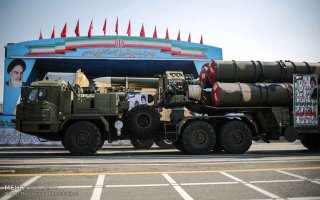With Israel’s recent taking of key geography inside Syria, there is now the realistic possibility for Israeli warplanes to launch airstrikes against key targets deep inside of the Islamic Republic of Iran. Indeed, reports now abound that the Israelis and the incoming Trump administration have been talking about conducting a massive air campaign directed against the flailing Islamist regime of Iran.
All this comes on the heels of Israel's successful airstrikes against Iran’s complex network of air defenses that, according to the Israeli military, decimated Iran’s purportedly sophisticated layered air defense network.
Did the Israelis Destroy Iran’s Air Defenses?
The Israelis claim that their highly advanced F-35I “Adir” warplanes struck hard and deep into an unsuspecting Iran, resulting in the total destruction of the Russian-provided S-300 air defense systems the Iranians had arrayed around key government and military sites. Of course, the Iranians have more than just those S-300s in their air defense network. But the S-300s were among some of the most advanced systems the Iranians had at their disposal.
If the Israeli claims are indeed accurate, then there is a considerable gap in Iran’s air defenses, meaning that there now exists a window for Israel, and possibly even the United States, to launch the mother of all air wars against the Iranian regime. The ostensible goal would be to destroy Iran’s most unwanted suspected nuclear weapons facilities.
Of course, given Israeli Prime Minister Benjamin Netanyahu’s consistent statements in favor of possible regime change in Iran, and the fact that President-elect Donald Trump has placed many Iran hawks on his national security team, it is unlikely that the rumored air campaign would end simply at destroying Iran’s suspected nuclear sites.
And this is the rub. Because a regime change operation, even if limited to covert action and air attacks, would be a highly complicated, sordid affair that would require far more commitment from both Israel and the United States than what the peoples of those two nations would likely support.
What’s more, the enemy—the vicious Islamic Republic of Iran, in this case—always gets a vote.
Sure, Iran’s air defenses were clipped in a seriously damaging way by the Israelis with their airstrikes. Apparently, the Iranians have adapted to some degree by fielding their indigenously produced 9-Dey short-range, low-altitude air defense system that was developed by the Iranian Revolutionary Guard Corps (IRGC), the elite military and ideological wing of the Islamic Republic. The system is designed to counter aerial threats ranging from incoming fighter jets to helicopters to unmanned aerial vehicles (UAVs). Beyond those threats, the 9-Dey is meant to intercept cruise missiles and even munitions dropped from enemy aircraft.
The 9-Dey Air Defense System
The system is believed to possess an effective range that extends from three to 21 miles and an operational ceiling of a little bit more than 12 miles high. So this system is capable of engaging low-to-medium altitude threats indicating its complexity and versatility, which for an indigenously produced Iranian system is more impressive than the usual systems the Islamic Republic deploys.
Iran’s 9-Dey system rides atop a six-by-six chassis, allowing for rapid deployment and a high degree of mobility. 9-Dey is equipped with a radar system that can detect and track multiple threats at various altitudes simultaneously. Specifically, the S-Band phased array radar has a detection range of up to 74 miles.
Two blocks of four containerized missiles define the weapon system. The missiles these cannisters fire are typically controlled by a command guidance system, which involves receiving directions from the ground-based radar that steers the launched missiles toward their intended targets. Because of this feature, the missile system is affordable due to the fact that the missiles launched from it are lightweight. And they are lightweight missiles because the missiles do not need an onboard guidance system.
As noted above, the 9-Dey missile defense system is part of a larger, more complex layered air defense network. The network is meant to protect critical infrastructure and counter potential threats from Iran’s enemies. Thus, integrating the short-range 9-Dey systems with others, such as the Khordad-15 and Bavar-373, the Iranians mean to create a robust, reliably, indigenously built (mostly, at least) defense shield against enemy incursions of Iran’s airspace.
Iran Really Can’t Stop the Israelis or Americans in an Air War
The 9-Dey system is an important demonstration by an increasingly embattled and surrounded Islamic Republic of Iran that they can, in fact, produce dangerous weapons that can defend their airspace.
By deploying increasing numbers of these systems, the Iranians are likely hoping to fill whatever gaps that the Israeli airstrikes created (although, the 9-Dey is not even in the same league as the allegedly destroyed Russian-built S-300s). It remains to be seen if any of Iran’s systems can live up to their hype. But, US and Israelis leaders should be careful not to bite off more than they can chew militarily.
Brandon J. Weichert, a Senior National Security Editor at The National Interest as well as a Senior Fellow at the Center for the National Interest, and a contributor at Popular Mechanics, consults regularly with various government institutions and private organizations on geopolitical issues. Weichert’s writings have appeared in multiple publications, including the Washington Times, National Review, The American Spectator, MSN, the Asia Times, and countless others. His books include Winning Space: How America Remains a Superpower, Biohacked: China’s Race to Control Life, and The Shadow War: Iran’s Quest for Supremacy. His newest book, A Disaster of Our Own Making: How the West Lost Ukraine is available for purchase wherever books are sold. He can be followed via Twitter @WeTheBrandon.
Image: Wikimedia Commons.

